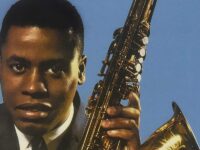A half-century ago this past Christmas Eve, the living legend saxophonist and composer Wayne Shorter went into a studio with an extraordinary array of peers to make the recordings that, more than any other album, is the reason why we often put that word ‘legend’ in front of his name.
Speak No Evil is arguably the crown jewel of Blue Note Records. It’s not a statement made lightly, since the fabled label had a (Alfred) Lion’s share of classic jazz LP’s, such as Blue Trane, Moanin’, Back at the Chicken Shack, Maiden Voyage, The Sidewinder and the album that this site is more-or-less named after. Cool but swaggering, modern but mindful of the majesty of jazz that preceded it, Speak No Evil — like all perfect records — is the product of a perfect confluence of timing and personnel.
Wayne Shorter had steadily built up a reputation as a fast-budding tenor saxophonist and composer while a member of Art Blakey’s Jazz Messengers in the early 60s. By the time he left the group in 1964 and shortly afterwards became the crucial last piece in Miles Davis’ second great quintet, Shorter had already made a handful of albums and the last couple were with Blue Note. Night Dreamer and Juju were recorded earlier in ’64, showcasing a rare talent that was rapidly approaching his peak. Even Juju, with notable originals like “Juju” and “Yes and No,” was already good enough to rightly be called a classic record.
But Shorter was just getting warmed up. For his next session called up on the day before Christmas, 1964, he assembled two of his new Miles Davis bandmates, Ron Carter (bass) and Herbie Hancock (piano), who would soon after lead a date from which Maiden Voyage sprung. The fiery trumpet champion Freddie Hubbard was selected to share the front line alongside the more reserved Shorter. John Coltrane’s drummer Elvin Jones rounded out this high powered quintet, and just a few weeks earlier, he had participated in the recording sessions of a jazz record even more iconic than this one. Lastly, these proceedings were overseen by producer and Blue Note co-founder Alfred Lion and taped by the distinguished engineer Rudy Van Gelder.
All that was left to guarantee greatness was Wayne Shorter’s own compositions. Like the celebrated Coltrane album made in the same month, Shorter had conjured up a collection of songs around a theme, but loosely so. “I was thinking of misty landscapes with wild flowers and strange, dimly-seen shapes — the kind of places where folklore and legends are born.” he told liner notes author Don Heckman. “And then I was thinking of things like witchburnings, too.” The imageries in his head informed these harmonies that are dark but not melancholy; they float freely but the Carter/Jones undertow of swing pulls against the overall mysterious feeling of Shorter’s compositions. That’s especially true for the ‘side one’ and ‘side two’ starting tunes “Witch Hunt” (examined in further detail here) and “Speak No Evil.”
Both of these performances feature Hubbard at his most impassioned, countered by Shorter’s inventive, non-traditional lines, but Hancock rhythmic sensibility on his own solo for the title track is equally satisfying. “Fee-Fi-Fo-Fum” cools down the mood somewhat, and is also a prime example of Shorter’s unorthodox harmonic constructions that all these years later continue to reveal only part of its mysteries. The same goes for “Dance Cadaverous” with its repeating chromatic chord changes and the ambiguous pulsations that tactfully add to the riddle of the song. Later on, Jones and Carter disguise the 6/4 signature of “Wild Flower” as a waltz.
The lone exception to this ‘black magic’ theme is Wayne Shorter’s paean to his young daughter Miyako. “Infant Eyes” features Shorter playing most of the three, nine measure phrases, not so much soloing but ‘singing’ through his tenor in a luscious tone.
These are just a few incidents of genius to be found throughout Speak No Evil, an album that fascinates as a symphonic Rubik’s Cube with sublime performances throughout and bursting with ideas that are as fresh today as they were fifty years ago.
- McCoy Tyner and Joe Henderson – ‘Forces of Nature: Live at Slugs’ (2024) - November 21, 2024
- Lydia Salnikova, “Christmas Means a Different Thing This Year” (2024): One Track Mind - November 19, 2024
- Darius Jones – ‘Legend of e’Boi (The Hypervigilant Eye)’ - November 15, 2024



